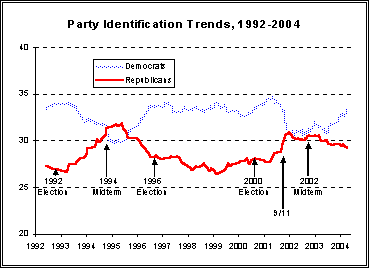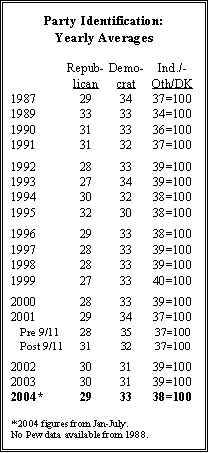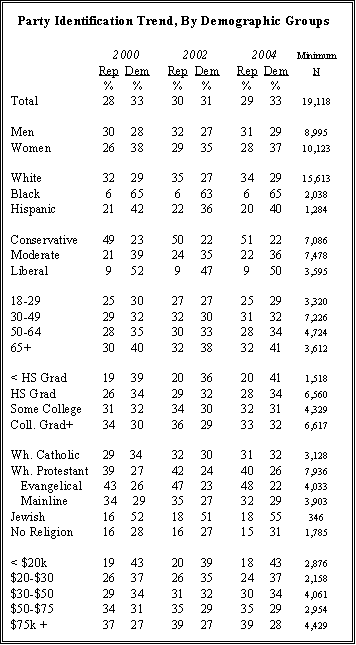The Democratic Party has achieved a small gain in party affiliation and holds a 33%-29% edge over the GOP in Pew surveys conducted in 2004. This represents a modest shift from the two year period following the Sept. 11, 2001 terrorist attacks, when the Republican Party had drawn virtually even with the Democrats.


The current balance in party identification is similar to 2000, when the Democratic Party held a 33%-28% advantage. The Democrats continued to lead during the first few months of the Bush administration. But the Sept. 11 attacks brought about a significant shift in party identification. The Republicans pulled into a virtual tie with the Democrats in the last few months of 2001, and yearly averages for 2002 and 2003 showed partisan parity continuing.
The same pattern is evident when independents who lean toward a party are included with partisans. In 2004 Pew surveys, Democrats hold a 47%-41% lead among partisans and party leaners; 12% decline to lean to one of the major parties. In 2002, Republicans and Democrats were at parity with leaners included (43%-43%), with 14% undecided. The current balance closely resembles 1999, when Democrats led 48%-40%, including leaners, with 12% undecided.
 White Catholics Still Split
White Catholics Still Split
The Democrats’ modest gains in 2004, like the GOP’s increases in the previous two-plus years, have come across the demographic spectrum. But some of the changes, while small, are notable. In the aftermath of Sept. 11, the Republicans made some inroads among women: in the yearly average for 2002, the Democrats held a six-point lead among women (35%-29%), half of what it had been in 2000 (38%-26%). In 2004 surveys, Democrats hold a nine-point lead among women (37%-28%). {See chart next page}
Among religious groups, Democrats have made slight inroads among white mainline Protestants: Republicans lead 32%-29% among this group, down slightly from the 2002 average (35%-27%). But Republicans continue to hold a commanding advantage among white evangelical Protestants (48%-22%). White Catholics continue to be evenly divided along partisan lines (32% Democrat/31% Republican), as they were in 2002. Four years ago, Democrats held a narrow 34%-29% lead among this important bloc.
In historical terms, the Democratic Party held a sizable lead over the Republicans in party identification for most of the 20th century, following the 1932 election of President Franklin Roosevelt. But the Republicans cut into the Democrats lead in the 1980s and the two parties nearly drew even by the time former President Ronald Reagan left office in 1989. The Democrats held a small lead in party affiliation in the late 1990s, only to lose that edge in the period following the attacks. (For a more detailed discussion of historical trends in party affiliation, see “Evenly Divided and Increasingly Polarized: The 2004 Political Landscape,” Nov. 5 2003, on the website of the Pew Research Center for the People and the Press, www.pewresearch.org/politics.)



